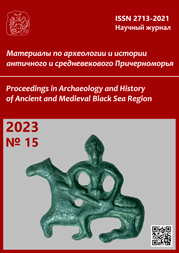Колесничество и верховая езда у скифоидного населения Северного Китая (культура янлан)
Chariotry and horse riding among the Scythian-like population of Nothern China (the Yanglang Culture)
Author(s): Petr I. ShulgaSubject(s): History, Archaeology, Prehistory
Published by: Нижневартовский государственный университет
Keywords: China; the Early Iron Age; pastoralists; chariots; cavalry;
Summary/Abstract: In the last decade, the issues of the emergence and further development of chariot racing have been increasingly raised. It is due to the activation of archeozoological research that the determining the degree and forms of horse exploitation by traces on teeth as well as by changes and deformations of horse bones became possible. The article analyzes the features of horse burials in Wangdahu (5th — 3rd century BCE) and Majiayuan (3rd — 2nd century BCE) burial grounds of the Yanglang Scythoid Culture with the involvment of the results of the detailed archeozoological study of horse skulls from Wangdahu. All available data clearly indicate that some of the deceased in Wangdahu were buried as warriors-charioteers with weapons and chariot horse cheek-pieces and parts of chariots; the skulls of four horses displayed traces of the bits on their teeth. Materials from elite burials in Majiayuan with real chariots and horse skeletons confirmed the conclusion that horse sculls in Wangdahu belong to chariot horses. These discoveries have demonstrated an extraordinary constructive and functional diversity of chariots, represented by various objects, from combat and parade quadrigas to large single-axle wagons drawn by four bulls. The data obtained from Wangdahu and Majiayuan burial grounds, left by the Western Rong, only demonstrate the use of chariots. Evidence of horse riding hasn’t yet been found. However, in some ancient Chinese narratives, the Western Rong population is noted to be excellent horsemen who were engaged to serve in the cavalry corps of the Qin army. An indirect confirmation of this is the presence of riding horses with the steppe-type saddles in the Qin Terracotta Army of the same period (the 2nd half of 3rd century BCE).
Journal: Материалы по археологии и истории античного и средневекового Причерноморья
- Issue Year: 2023
- Issue No: 15
- Page Range: 625-651
- Page Count: 17
- Language: Russian

